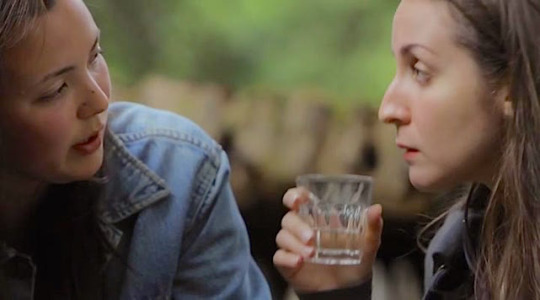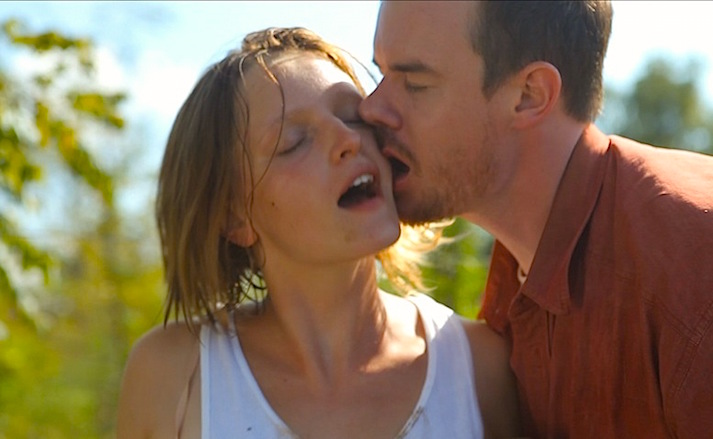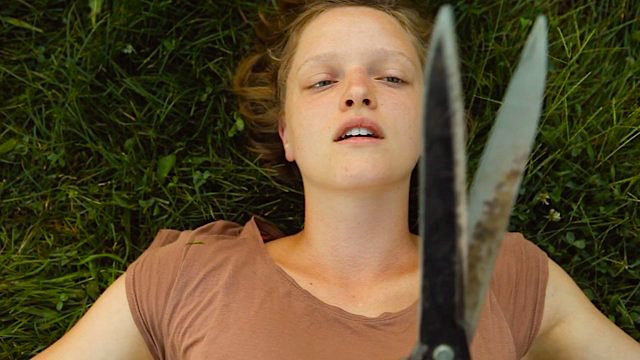After a decade in a successful career in cinematography, Nicolas Roeg found his way into the director’s chair. This led to a string of unforgettable films that blended his unique camera perspectives with an even more experimental editing to form

“I’m not a scientist. But I know all things begin and end in eternity.” David Bowie reflects in The Man Who Fell To Earth, Nicolas Roeg, 1976.
Cinematography | Anthony B. Richmond
Film Editor | Graeme Clifford
much more than cinematic stories. Nicolas Roeg used cinematography, editing and obsessions to form film art that seeps into the senses that often lift the viewer into an experience that is more than unforgettable. Roeg’s cinematic voice reaches almost hypnotic levels. He creates atmosphere, tension, eroticism and human introspection that calls us to revisit his films.

“This one who’s blind. She’s the one that can see.” Hilary Mason’s character may be blind, but she is the only character who can actually ‘see’ in Don’t Look Now, Nicolas Roeg, 1973.
Cinematography | Anthony B. Richmond
Film Editor | Graeme Clifford
With each revisit, the viewer discovers new aspects, ideas and meanings. Roeg quickly established a strong connection with both Cinematographer, Anthony B. Richmond and Film Editor, Graeme CliffordIn early on. Eventually, he would also establish a new film editing connection with Tony Lawson. These “connections” ran deep. In Roeg’s hands, filmmaking is no longer reduced to “orchestrated collaboration” “craft” or “storytelling” — Roeg’s cinematic work takes these fundamental concepts related to movie making to the level of true Film Art.

Art Garfunkel and Theresa Russells’ “terrifying obsession took them to the brink of death and beyond.” Bad Timing, Nicolas Roeg, 1980.
Cinematography | Anthony B. Richmond
Film Editor | Tony Lawson
It is more than a complex collaboration between the filmmaker and his/her cinematography and editor, in Nicolas Roeg’s work — it is clear that their is more than a shared aesthetic, the intermingling of all three aspects of filmmaking feel to be forming together in a genetic sort of alchemy. This is the magic of Pure Cinema.
The influence of Nicolas Roeg is undeniable. He has inspired far too many filmmakers to list. And, if one did comprise a list it would reflect a wide range of cinematic visionaries. Ridley Scott, Danny Boyle and François Ozon are just a few notably varied filmmakers who have listed Roeg as a strong influence.

It is often the most seemingly surprisingly magnified small detail that means so much. Candy Clark pours a drink. “You know Tommy, you’re a freak. I don’t mean that unkindly…” with questionable intent in The Man Who Fell To Earth, Nicolas Roeg, 1976.
Cinematography | Anthony B. Richmond
Film Editor | Graeme Clifford
It is also important to note that Nicolas Roeg has never taken the stance of “Film Artiste” — Despite the complexities of what one discovers in his films, he has consistently dismissed the idea that he has ever pursued a film with one sole purpose. Instead, he will often shrug off aspects of his work as “accidental” or “luck” — And further to the point, Roeg claims to have never set out to rebel against fixed ideas of what cinema should be. He has always expressed how important his early work as a part of a camera unit or cinematographer were essential so the he could gain the essential knowledge of film craftsmanship. He once was quoted, “The rules are learnt in order to be broken, but if you don’t know them, then something is missing.”

“The churches belong to God, but he doesn’t seem to care about them.” Don’t Look Now, Nicolas Roeg, 1973
Cinematography | Anthony B. Richmond
Film Editor | Graeme Clifford
The use of sound and image do not always match in Nicolas Roeg’s cinematic world. What we are “allowed” to see is not always what we think we “want” to see. Mirrors and all aspects of reflection begin to take on added significance as these films move forward. The use of mirrors serves as far more than presenting an interesting thought — they are the tools that these characters discover everything insights into existentialism, desire, fear, vanity, gender roles and identity. The reflection of mirrors and glass have a similar impact on the audience but with added psychological dimensions that are inaccessible to the characters.

““I’ve used mirrors in a lot of movies. I think the mirror is an extraordinary thing, also the reflective, a reflection in water etc. Don’t you think it’s something strange that you rarely look at yourself in the mirror, except to do things like stand and ponder? ” Nicolas Roeg on the use of mirrors in his films. Here, James Fox, is forced to not only re-evaluate his identity but his gender in Performance, Nicolas Roeg & Donald Cammell, 1970
Cinematography | Nicolas Roeg
Like many great artists, Nicolas Roeg is sometimes so ahead of the audience that a film may fail to connect. This was the case with the controversial study of sexual desire turned to obsessions that potentially lead to insanity or something far worse. Largely dismissed when it was released, it has since gained much more success with audiences as time has passed.
Roeg’s interests in how men and women connect sexually often become a core element found in every film. In Bad Timing he allowed his and the characters’ obsessions to overflow with a level of intensity that often resulted in confused responses. Seven years earlier, in Don’t Look Now, he created an almost uncomfortably level of erotic intimacy between Julie Christie and Donald Sutherland that so shocked audiences that it is still a matter of discussion when the film is screened. The reality of sexuality becomes heightened to the abnormal in Bad Timing, but sexuality is used in a casually realistic way in Don’t Look Now.

Julie Christie and Donald Sutherlands’ characters infamously make love and cause Movie Rumor that remains today in Don’t Look Now, Nicolas Roeg, 1973
Cinematography | Anthony B. Richmond
Film Editor | Graeme Clifford
Viewers in 1980 seemed to have had a difficult time finding “reality” in the sex of Bad Timing. But well over 30 years later, the infamous sex scene in Don’t Look Now “feels” so real that many insist on believing that Sutherland and Christy were actually engaging in penetrative sex. The magical use of sex in Don’t Look Now is that it slowly dawns on the audience that this graphic display of sexual connection is not used for titaliation, but to capture the all too human need to connect to his/her lover in times of grief. It is a reconnection that almost helps this marriage in crisis pull itself out of disaster. Well, almost.
Another aspect of Roeg’s approach to his films that is rather thrilling is the ever present use of Surrealism. But it is the almost casual way in which surrealism mixes in with blunt realism. A level of disorientation flows off the screen because while we think we know that some of what we are seeing is “surreal” — it could almost as easy be called “real”
The Man Who Fell To Earth is a great example of film which refuses to ground itself into any conventional genre: Is it satire? Or is it an oddly ‘realistic’ Sci-Fi? Maybe it is dark humored metaphorical study of humankind? Is it surrealism? Is it about owning our identity no matter how our society tries to suppress us?

The Man Who Fell To Earth, Nicolas Roeg, 1976
Cinematography | Anthony B. Richmond
Film Editor | Graeme Clifford
What is real and what is often tangible but not easily labeled is often the most important aspect of our journey. Nicolas Roeg once noted, “I love that perhaps we don’t see the things that are there because we have no reliable yardstick to see things by, to compare them.”

Pass the warning…
Don’t Look Now
Nicolas Roeg, 1973
Cinematography | Anthony B. Richmond
Film Editor | Graeme Clifford
Over the last several years I have had the pleasure of spending a great deal of time with Don’t Look Now. As it made its way from the muddy VHS transfer to an improved but still lacking quality when it was released on DVD in both the US/UK to the beautifully restored version issued to blu-ray/DVD by the magic-makers at Criterion. I’ve needed to watch this film a number of times for various reasons. I’ve lost count of how many times I have seen it in the last three years. But every time I watch it, I notice something new. Never have I seen a film so disturbingly horrific turn itself into something of altogether different that can only be termed as “Human” beauty.

“One of your children has posed a curious question: if the world is round, why is a frozen lake flat?” The answer to his daughter’s question is far more complex than Donald Sutherland can fully grasp. He fights against his instincts in Don’t Look Now, Nicolas Roeg, 1973
Cinematography | Anthony B. Richmond
Film Editor | Graeme Clifford
Don’t Look Now takes us to a Venice steeped in decay, sadness and uncertain dangers. We are led through a series of seemingly endless loop of dark tunnels. We pass over aged bridges in a fog of mystery. Hope can become deadly. Grief can become a release. Like life, nothing is at it appears.
If you’ve ever had the pleasure of listening to Nicolas Roeg speak, you will note a highly intelligent and genuine man. It is impossible to miss the fact that he is so filled with ideas that he tends talk in meandering and circular sentences. The newly released Criterion edition of Don’t Look Now features a discussion filmed in 2003 at London’s Ciné Lumière. It is an entertaining discussion and, in some ways, a revealing way in which Roeg not only communicates — but how he thinks.
And, this, to me, adds insight into the way he views film editing. There is not so much concern with editing a film in a linear or altogether logical way — because when we really think about it — Our minds are constantly racing through ideas, memories, feelings, emotions, worries and ever spinning topics as we navigate through ever part of our day.
Nicolas Roeg’s movies strive to capture worlds through the lens of the human mind’s perspective. Our mind never fully allows our eyes, ears and senses to fully focus on one thing. Instead, our minds take in everything at once and while we are largely successful at deciphering our experience of the world and the situations we experience. It is only long after something has happened that we have the opportunity to “process’ an event. This is perhaps the strongest element to be found in the way Nicolas Roeg often transcends the normally anticipated scope of a movie.
I recently discovered a website called The TalkHouse which features brilliantly insightful writing and articles related to art.
Lance Edmands is a film artist himself and one of the contributors to the site. He has written a great piece in which he deconstructs Don’t Look Now‘s opening sequence. If you’ve not visited The TalkHouse or read anything by Lance Edmands, I encourage you to follow this link. He offers a far more in-depth discussion of Roeg’s experimental work.
http://thetalkhouse.com/film/talks/lance-edmands-bluebird-talks-nicolas-roegs-dont-look-now/































